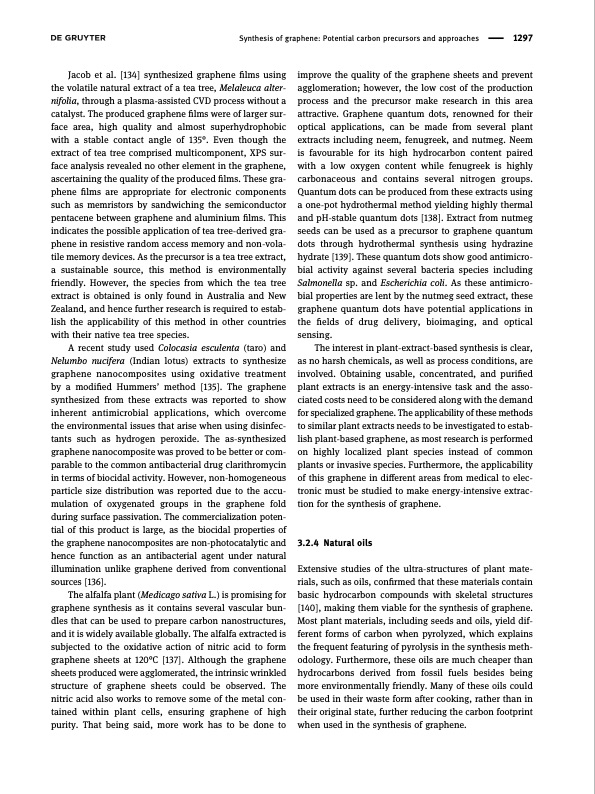PDF Publication Title:
Text from PDF Page: 014
Synthesis of graphene: Potential carbon precursors and approaches 1297 Jacob et al. [134] synthesized graphene films using the volatile natural extract of a tea tree, Melaleuca alter- nifolia, through a plasma-assisted CVD process without a catalyst. The produced graphene films were of larger sur- face area, high quality and almost superhydrophobic with a stable contact angle of 135°. Even though the extract of tea tree comprised multicomponent, XPS sur- face analysis revealed no other element in the graphene, ascertaining the quality of the produced films. These gra- phene films are appropriate for electronic components such as memristors by sandwiching the semiconductor pentacene between graphene and aluminium films. This indicates the possible application of tea tree-derived gra- phene in resistive random access memory and non-vola- tile memory devices. As the precursor is a tea tree extract, a sustainable source, this method is environmentally friendly. However, the species from which the tea tree extract is obtained is only found in Australia and New Zealand, and hence further research is required to estab- lish the applicability of this method in other countries with their native tea tree species. A recent study used Colocasia esculenta (taro) and Nelumbo nucifera (Indian lotus) extracts to synthesize graphene nanocomposites using oxidative treatment by a modified Hummers’ method [135]. The graphene synthesized from these extracts was reported to show inherent antimicrobial applications, which overcome the environmental issues that arise when using disinfec- tants such as hydrogen peroxide. The as-synthesized graphene nanocomposite was proved to be better or com- parable to the common antibacterial drug clarithromycin in terms of biocidal activity. However, non-homogeneous particle size distribution was reported due to the accu- mulation of oxygenated groups in the graphene fold during surface passivation. The commercialization poten- tial of this product is large, as the biocidal properties of the graphene nanocomposites are non-photocatalytic and hence function as an antibacterial agent under natural illumination unlike graphene derived from conventional sources [136]. The alfalfa plant (Medicago sativa L.) is promising for graphene synthesis as it contains several vascular bun- dles that can be used to prepare carbon nanostructures, and it is widely available globally. The alfalfa extracted is subjected to the oxidative action of nitric acid to form graphene sheets at 120°C [137]. Although the graphene sheets produced were agglomerated, the intrinsic wrinkled structure of graphene sheets could be observed. The nitric acid also works to remove some of the metal con- tained within plant cells, ensuring graphene of high purity. That being said, more work has to be done to improve the quality of the graphene sheets and prevent agglomeration; however, the low cost of the production process and the precursor make research in this area attractive. Graphene quantum dots, renowned for their optical applications, can be made from several plant extracts including neem, fenugreek, and nutmeg. Neem is favourable for its high hydrocarbon content paired with a low oxygen content while fenugreek is highly carbonaceous and contains several nitrogen groups. Quantum dots can be produced from these extracts using a one-pot hydrothermal method yielding highly thermal and pH-stable quantum dots [138]. Extract from nutmeg seeds can be used as a precursor to graphene quantum dots through hydrothermal synthesis using hydrazine hydrate [139]. These quantum dots show good antimicro- bial activity against several bacteria species including Salmonella sp. and Escherichia coli. As these antimicro- bial properties are lent by the nutmeg seed extract, these graphene quantum dots have potential applications in the fields of drug delivery, bioimaging, and optical sensing. The interest in plant-extract-based synthesis is clear, as no harsh chemicals, as well as process conditions, are involved. Obtaining usable, concentrated, and purified plant extracts is an energy-intensive task and the asso- ciated costs need to be considered along with the demand for specialized graphene. The applicability of these methods to similar plant extracts needs to be investigated to estab- lish plant-based graphene, as most research is performed on highly localized plant species instead of common plants or invasive species. Furthermore, the applicability of this graphene in different areas from medical to elec- tronic must be studied to make energy-intensive extrac- tion for the synthesis of graphene. 3.2.4 Natural oils Extensive studies of the ultra-structures of plant mate- rials, such as oils, confirmed that these materials contain basic hydrocarbon compounds with skeletal structures [140], making them viable for the synthesis of graphene. Most plant materials, including seeds and oils, yield dif- ferent forms of carbon when pyrolyzed, which explains the frequent featuring of pyrolysis in the synthesis meth- odology. Furthermore, these oils are much cheaper than hydrocarbons derived from fossil fuels besides being more environmentally friendly. Many of these oils could be used in their waste form after cooking, rather than in their original state, further reducing the carbon footprint when used in the synthesis of graphene.PDF Image | Synthesis of graphene Potential carbon precursors

PDF Search Title:
Synthesis of graphene Potential carbon precursorsOriginal File Name Searched:
10-1515-ntrev-2020-0100.pdfDIY PDF Search: Google It | Yahoo | Bing
Salgenx Redox Flow Battery Technology: Power up your energy storage game with Salgenx Salt Water Battery. With its advanced technology, the flow battery provides reliable, scalable, and sustainable energy storage for utility-scale projects. Upgrade to a Salgenx flow battery today and take control of your energy future.
CONTACT TEL: 608-238-6001 Email: greg@infinityturbine.com (Standard Web Page)